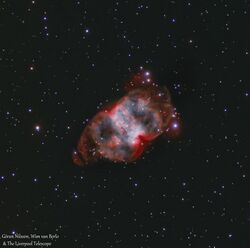Astronomy:Little Dumbbell Nebula
| Emission nebula | |
|---|---|
| Planetary nebula | |
 Color composite image of the Little Dumbbell image, as taken at the Liverpool Telescope | |
| Observation data: J2000.0 epoch | |
| Right ascension | 01h 42.4m |
| Declination | +51° 34′ 31″ |
| Distance | 2 500 ly (780 pc) |
| Apparent magnitude (V) | +10.1 |
| Apparent dimensions (V) | 2.7 × 1.8 arcmin (′) |
| Constellation | Perseus |
| Physical characteristics | |
| Radius | 0.617 ly |
| Designations | M76, NGC 650/651 |
The Little Dumbbell Nebula, also known as Messier 76, NGC 650/651, the Barbell Nebula, or the Cork Nebula,[1] is a planetary nebula in northern constellation Perseus. It was discovered by Pierre Méchain in 1780 and included in Charles Messier's catalog of comet-like objects as number 76. It was first recognised as a planetary nebula in 1918 by the astronomer Heber Doust Curtis. However, there is some contention to this claim, as Isaac Roberts in 1891 did suggest that M76 might be similar to the Ring Nebula (M57), being instead as seen from the side view.[2] The structure is now classed as a bipolar planetary nebula (BPNe), denoting two stars which have burst, leaving neutron star or white dwarf remnants and luminous envelopes.[3] Distance to M76 is currently estimated as 780 parsecs or 2,500 light years,[4] making the average dimensions about 0.378 pc. (1.23 ly.) across.[5]
The total nebula shines at the apparent magnitude of +10.1 with its central star or planetary nebula nucleus (PNN) at +15.9v (16.1B) magnitude.[1] The UV-light from the nucleus is growing a luminous nebula as its envelope, and has the surface temperature of about 88,400 K. Factoring in the solar system's movement and focussing on whether more approaching or parting, it is not receding, having radial velocity of −19.1 km/s.[6]
The Little Dumbbell Nebula derives its common name from its resemblance to the Dumbbell Nebula (M27) in Vulpecula. It was originally thought to consist of two separate emission nebulae so bears New General Catalogue numbers NGC 650 and 651.
See also
References
- ↑ 1.0 1.1 "M 76 – Planetary Nebula". SIMBAD. Centre de Données astronomiques de Strasbourg. http://simbad4.cfa.harvard.edu:8080/simbad/sim-id?Ident=%4084066&Name=M%20%2076&submit=submit.
- ↑ "Messier 76". The SEDS Messier Catalog Webpages. http://messier.obspm.fr/m/m076.html.
- ↑ Ramos-Larios, G.; Phillips, J. P.; Cuesta, L. (2008). "The visual and mid-infrared properties of the bipolar planetary nebula NGC 650-1". Monthly Notices of the Royal Astronomical Society 391 (1): 52–62. doi:10.1111/j.1365-2966.2008.13886.x. Bibcode: 2008MNRAS.391...52R.
- ↑ Philips, J.P. (2005). "The distances of highly evolved planetary nebulae". Monthly Notices of the Royal Astronomical Society 357 (2): 619–625. doi:10.1111/j.1365-2966.2005.08676.x. Bibcode: 2005MNRAS.357..619P.
- ↑ Philips, J.P. (2002). "The Distances of Planetary Nebulae: A Scale Based upon Nearby Sources". Astrophysical Journal Supplement Series 139 (1): 199–217. doi:10.1086/338028. Bibcode: 2002ApJS..139..199P.
- ↑ Philips, J.P. (2002). "The Distances of Planetary Nebulae: A Scale Based upon Nearby Sources". Astrophysical Journal Supplement Series 139 (1): 199–217. doi:10.1086/338028. Bibcode: 2002ApJS..139..199P.
External links
- The Little Dumbbell Nebula on WikiSky: DSS2, SDSS, GALEX, IRAS, Hydrogen α, X-Ray, Astrophoto, Sky Map, Articles and images
- NightSkyInfo.com – M76, the Little Dumbbell Nebula
- Little Dumbbell Nebula (M76, NGC 650 and 651)
- The Little Dumbbell Nebula @ SEDS Messier pages
- Hardy, Liam; Crowther, Paul. "M76 – Little Dumbbell". Deep Sky Videos. Brady Haran. http://www.deepskyvideos.com/videos/messier/M76_little_dumbbell.html.
Coordinates: ![]() 01h 42.4m 00s, +51° 34′ 00″
01h 42.4m 00s, +51° 34′ 00″
 |


